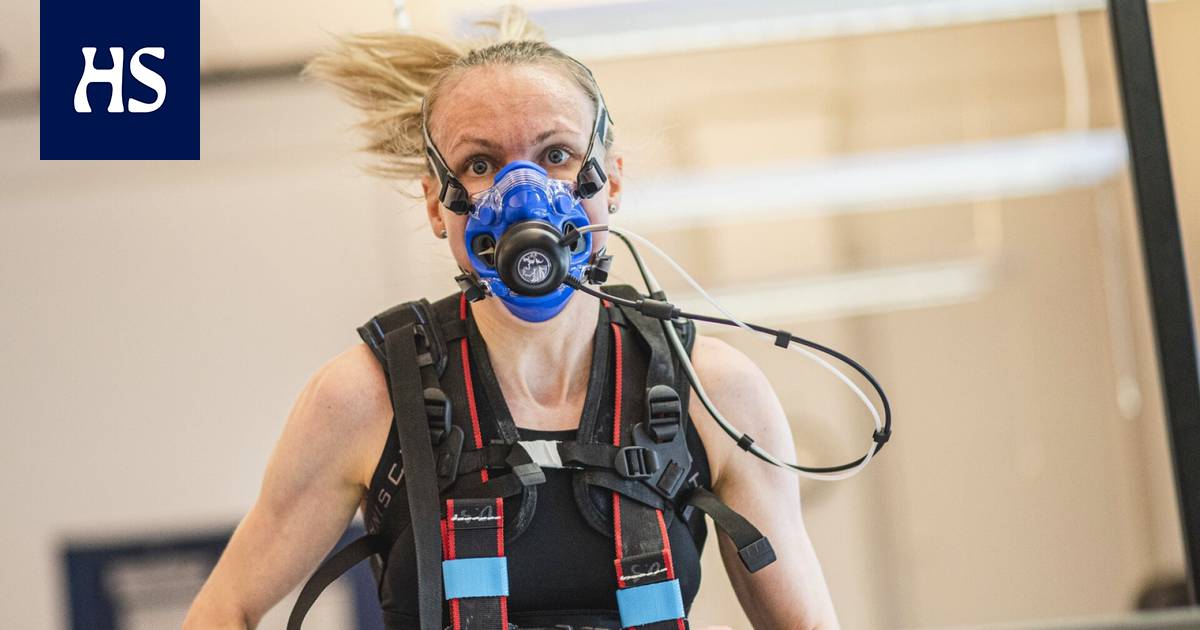Mountain runner Susanna Saapunki blew a wild result in the oxygen uptake test and explained why her weight has dropped nearly ten percent since the skiing career.
Rovaniemi
“This is the most brutal test I’ve ever done ”, a former national team skier and current mountain runner Susanna Saapunki and has gained experience from various tests.
The situation in the test room of Lapland Sports College in Rovaniemi is exciting. It is about physical performance, endurance properties and especially the maximum oxygen uptake that can be measured from any person.
It is now time to measure how successful 29-year-old Saapung has been trained as a professional mountain runner during the winter in northern Italy.
As a skier, Saapunki has blown readings of up to 82 milliliters (per kilogram of body weight per minute) in the relatively maximum oxygen uptake test. So let’s talk about the same numbers as the Norwegian ski horror Therese Johaugin is said to have measured.
In Finland, Saapungi’s readings are among the highest ever for women. However, the results obtained at different times and with different test mats are not fully comparable.
Rapsakka a spring storm pushes in fresh air from an open window as Saapunki does a warm-up.
The city will take the maximum test according to the template used by the mountain runners. The untested slope is 12.5 percent, or about seven degrees. It practically corresponds to a hill, where at a distance of one hundred meters you ascend 12.5 meters vertically, that is, measured vertically.
For example, on the World Championships in 2021 in Oberstdorf, Germany, the average steepness of the much-talked-about and exceptionally hard rise of Burgstall was ten percent.
Those who understand the world of road cycling also know that 12.5 per cent means a really steep climb when ridden for half an hour, for example.
“
“It’s kind of blunt.”
In the runner’s oxygen uptake test, the steepness of the mat was 12.5 percent throughout.
City personal trainer and appetizer Kari Miettunen says before the test that the angle of the mat practically corresponds to the kind of steepness that Saapunki encounters in many competitions.
When the warm-up is done, the town wears a safety harness and a breathing mask on her face.
In the test, the speed is increased every two minutes. The first two speeds (5 and 5.5 kilometers per hour) the city finds out on foot.
When the tester raises the speed to six kilometers per hour after four minutes of walking, Saapunki puts on a run. The step is shallow and short, but that’s how it should be.
“Uphill running doesn’t look like normal running at all because the step has to be as short as possible. It’s kind of blunt, ”Miettunen explains.
“
“Toast, toast. Focus, focus. ”
Test progresses, the speed of the carpet accelerates and the heart rate of the Rise rises. Miettunen sometimes encourages and reminds about running techniques.
“Relaxed and calm, as relaxed as possible.”
With 18 minutes left, Saapung’s heart rate is in the 180 range. Ventilation and oxygen consumption work well.
“Just get there, on top of the hill. Rhythm, rhythm, rhythm, ”Miettunen shouts as we approach the point where Saapunki was in a test conducted in November last year.
That’s when he fought on the carpet for 24 minutes and 50 seconds before exhaustion.
“Toast, toast. Focus, focus, ”Miettunen encourages when 26 minutes are full.
This time, Saapunki hangs on the mat for 26 minutes and eight seconds. Miettunen reports that Saapunki has blown at a relative maximum oxygen uptake of 77 milliliters per kilogram of body weight per minute.
The corresponding reading in the autumn test was 75. Miettunen estimates that the result obtained now would correspond to more than 80 readings in the ski test. The difference arises from the fact that in running, the muscles of the upper body do little work.
“This is a very hard result when run,” says Miettunen.
“
“As a skier, I weighed about 50 pounds, now it’s 46.”
The test for maximal oxygen uptake usually ends in exhaustion.
Thoughtfully However, according to the Commission, the primary purpose of that test was not to determine the maximum oxygen uptake but, inter alia, to determine the so – called anaerobic threshold upstream, at which no recovery is possible.
“The question is how fast Sussu can run uphill.”
Miettunen calculates that during the test, Saapunki advanced 3.5 kilometers and had a vertical ascent of 440 meters.
Saapunki is also satisfied after the test.
“I am confident that our system will work. We have come a long way. ”
When it is a matter of relative maximum oxygen uptake, the city somehow benefits from being very lightweight.
“As a skier, I weighed about 50 pounds, now it’s 46. But at no point have I lost my weight. The weight has left the muscles, the hands left immediately, ”says Saapunki and refers to giving up the skier’s training a good year ago.
The point is that running uses different muscles than skiing. According to Miettusen, Saapung’s fat percentage is unchanged.
Last week, Saapunki already did one carpet test, which Miettunen has modified to suit his purposes.
In it, the test began with an increase of only one percent, but the steepness of the carpet was gradually increased. At that time, the last steepness was 16 percent.
“
“I’ve got to focus on the essentials and practice hard.”
Susanna Saapunki, who has been visiting Finland for a couple of weeks, ran the test in Rovaniemi.
In Finland The town is a two week visit. Before the carpet tests, he underwent a comprehensive health check-up and also checked his teeth.
Next weekend, Saapunki will be looking for a competitive feel at the Finnish Cross Country Championships in Nakkila. In last spring’s competition, he finished seventh in the top ten.
“I promise I’m in a whole different condition now than I was then.”
Then there is a return to northern Italy, where Saapunki lived with her husband for the first time all winter. Ville Miettusen with.
The couple lives near Bormio in the small village of Valfurva, located at an altitude of 1,400 meters.
“The winter went really well. From a runner’s perspective, there was virtually no winter there. On foot, I was dealing with snow for maybe five days. It can be said that as a runner I have been able to train all winter in absolutely perfect conditions. ”
As a skier The city was never able to reach its full potential. The most significant hurdle was asthma and related lung problems already diagnosed as a child.
“Everything has gone well now. There have been no problems with the lungs and no compromises of any kind have had to be made. I have been able to focus on the essentials and practice hard. ”
Saapunki says their current apartment is a studio unit.
“We’ve spent that kind of local mountain life. The winter was interesting. The nights were cold and the Italians did not use any basic heat. We heated the cabin all winter with such a tiny pellet stove. It was like being in a cottage somewhere. ”
“
“I’ve got to focus on the essentials and practice hard.”
With these prospect The city will compete in the Mountaineering World Cup for the first time under Midsummer in Portugal. There are now nine out of 12 races on the calendar. There will be enough of them in different countries until October.
This season, he focuses on so-called up and down races, where about 70 percent of the performance time is run uphill and 30 percent downhill.
The main events of the season are the European Championships in La Palma in the Canary Islands in July and the World Championships in Thailand in November, which were postponed twice due to the corona epidemic.
“On the first day of the European Championships, there will be an eight-kilometer race with a thousand ascent meters. After the break, there is a normal distance of 18 kilometers, the ascent of which is likely to be just under a tonne. ”
The Sierre – Zinal, a classic of the species, is also on the Swiss calendar in August in Switzerland. Its route has an ascent of about 20 kilometers and a downhill of about 10 kilometers.
The race is also known for the fact that its route shows five peaks rising to an altitude of more than 4,000 meters.
“It’s my first long-distance race in the World Cup, 31 miles. I didn’t originally plan it myself, but the team manager and Kari thought that based on the training I would be able to run it. It is now a little longer race. ”
The city was pleased after the test.
Read more: Susanna Saapung’s first season as a mountain runner has brought lessons, success, panic ingredients and a view to Italian sports culture: “Festivals for the whole nation”
Read more: Susanna Saapunki wants to be the top of the world in a grueling mountain run – and an exceptional feature helps her
Read more: Path runner Anna-Stiina Erkkilä had run 27 minutes in the first oxygen uptake test of her life and her heart rate hit 190 when she hit a limit that could not be exceeded
#Running #brutal #test #Susanna #Saapunki #mountain #runner #blew #wild #result #oxygen #uptake #test

/s3/static.nrc.nl/wp-content/uploads/2024/04/web-2604buicharles.jpg)







